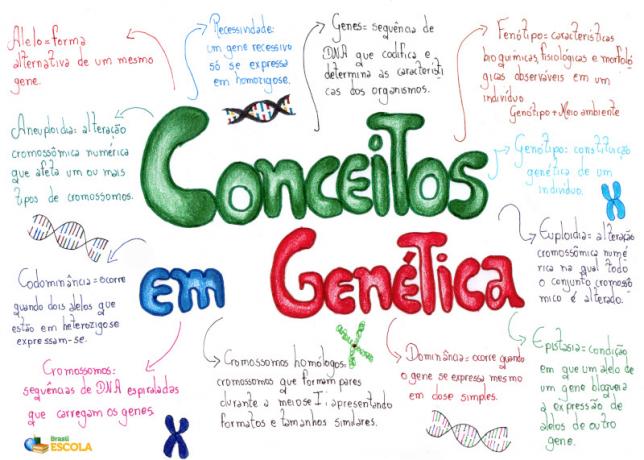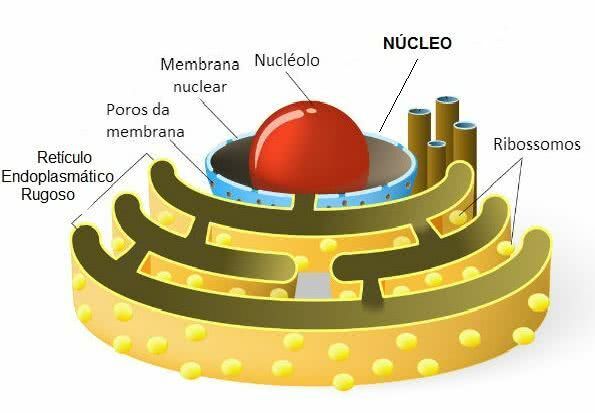Since antiquity, man has sought to understand how the transmission of characteristics from one being to another occurs. Early ideas about heredity were quite simple and just claimed that children were similar to their parents, without understanding the mechanism behind this finding.
Genetics is the part of biology that studies heredity, that is, the way the characteristics are passed on from generation to generation. It is considered that this science began with the experiments and laws proposed by a monk named Gregor mendel, in a work published in 1866.
Mendel hoped, with the development of his pea work, to understand why crossbreeding between hybrids generated such different offspring. According to some authors, with these works, Mendel intended to create ways to develop hybrid plants that conserve important characteristics for agriculture.
Mind Map: Concepts in Genetics

* To download the mind map in PDF, Click here!
To carry out his work, Mendel chose peas and analyzed seven characteristics: size of plant, seed texture, seed color, pod shape, pod color, flower color and position of the flower. The choice of plant was essential for the success of his research, since the pea is easy to grow, has several seeds and a short reproductive cycle.
One of the laws proposed by Mendel in his work was the factor segregation, known today as genes. According to the researcher, each person has a pair of factors for each characteristic that is separated at the time of gamete formation. At the time of fertilization, the father and mother's gametes join, taking their characteristics with them.
Mendel contributed in a great way to the studies of Genetics and, therefore, is considered today the father of this science. The works of this researcher, however, were forgotten for many years, without any use. However, in 1900, researchers Correns, Tschesmak, and De Vries independently rediscovered Mendel's work by studying hybrid plants. These three botanists contributed to the acceptance of Mendel's ideas and to the beginning of genetic studies in humans.
Do not stop now... There's more after the advertising ;)
Another work that deserves to be highlighted is that of Morgan, who studied the fruit fly and understood that the transmission of some characteristics was determined by sex. His work has given special focus to mutations and their transmission to offspring. In 1926, this researcher published the book Theory of the Gene, in which he explained that heredity is linked to units passed from parent to offspring.
Years later, Genetics underwent a major advance with the discovery that the DNA it would be the key structure that carried the genetic information. Among the various works with this molecule, Watson, Crick, Wilkins and Franklin, in 1953, stood out, which demonstrated the double helix structure of DNA.
After the discovery of the structure of DNA, several other works were carried out in order to understand who was responsible for producing the proteins. The idea that DNA would be responsible for RNA synthesis and that this, in turn, would be responsible for the production of proteins was postulated by Crick, in 1958, and became known as Central Dogma of Molecular Biology.
From these discoveries, several advances occurred in Molecular Biology and directly affected the development of Genetics. Among these important advances, the technique of recombinant DNA, which is characterized by the ability to isolate a stretch of DNA and place it in a bacterium in order to produce copies of that stretch. With this, it was possible to make organisms produce substances of economic interest.
The advance of genetics has completely changed the current world, making it possible, for example, to create clones, transgenic foods resistant to pests, carry out paternity tests and solve crimes, map diseases and carry out genetic counseling.
Check out the texts below to learn about the news in the field of genetics and understand the principles that guide this field of Biology studies.
Good studies!
By Ma. Vanessa dos Santos
A) ( ) Heredograms are graphical representations of kinship relationships between individuals in a family.
B) ( ) We can say that the genotype is the result of the interaction between the phenotype and the environment.
C) ( ) Test crosses are used, among other things, to determine genotypes.
D) ( ) A man of blood B and a woman of blood A cannot have children of blood type O.
E) ( ) A man of blood O and a woman of blood A cannot have children of blood type B.


